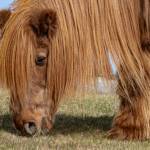PPID Management in Horses: Monitoring Essential After Diagnosis

Researchers recently published a “clinical audit” of how horses with pituitary pars intermedia dysfunction (PPID, equine Cushing’s disease) are managed following diagnosis. The report showed that recommended follow-up monitoring was only being performed in about half of all cases. Improved monitoring using current evidence-based guidelines is encouraged because unregulated PPID horses may have an increased risk of endocrine-associated laminitis.
As outlined in the clinical audit, treatment and monitoring recommendations for horses diagnosed with PPID include:
- Start pergolide therapy at 2 ug/kg by mouth once daily;
- Evaluate clinical response to pergolide therapy and assess laboratory indicators of PPID between one and three months after starting pergolide;
- Repeat endocrinologic (blood) testing every four to six weeks thereafter until either stabilization or improvement in clinical signs.
Adrenocorticotropic hormone (ACTH) testing was recommended for follow-up, and excessive hair growth, delayed shedding, and laminitis were the most common clinical signs used for evaluating response to treatment.
After reviewing medical records and 2-6 years’ worth of follow-up data of horses diagnosed with PPID based on resting ACTH concentrations, the authors of the clinical audit found:
- Pergolide was administered to just over three-quarters of the 235 horses diagnosed with PPID, but the starting dose was inappropriately low in 13% of the treated horses;
- Overall, about 77% of PPID horses treated with pergolide were monitored; and
- Most (95%) horses were monitored using basal ACTH testing, but the remaining 5% were monitored based on clinical response alone (i.e., improved hair coat, laminitis).
“In addition, only 48% had follow-up basal ACTH testing within the recommended first one to three months following diagnosis,” explained Katie Young, Ph.D., a Kentucky Equine Research nutritionist.
Based on these findings, the main recommendation made by the researchers was improved monitoring.
Potential reasons for not routinely monitoring PPID horses include financial constraints by the owner or the veterinarians’ reactive approach to case management. Horses should be examined every six months in order to continue prescribing or dispensing pergolide.
“Biannual examinations and consultations allow veterinarians to discuss the horse’s diet with the owner. While there is no single recommendation for nutritional management of horses affected by PPID, consideration of nonstructural carbohydrate content of diets is important, particularly when the horse is at risk of laminitis,” Young said.
She added, “Geriatric horses often require specialized diets due to poor dentition, so owners must take care to ensure appropriate fiber intake for horses unable to process traditional forage sources.”
Owners are also encouraged to provide protein, vitamins, and minerals to meet nutritional requirements. Protein may be particularly important in the diets of PPID horses, as muscle atrophy is common with PPID.
A low-intake ration balancer provides protein, vitamins, and minerals without excess calories. This is an important consideration as many PPID horses are overweight. A high-quality vitamin and mineral supplement might also be appropriate in lieu of a ration balancer.
“Finally, because pergolide reportedly causes decreased appetite in some horses, it is important to evaluate and adjust the diet as needed to provide adequate calories and other nutrients to support body weight and condition. In some older horses, higher calorie feeds with extremely palatable ingredients and possibly flavorings may be warranted,” Young suggested.
*Steel, N.L., J.L. Ireland, and C.M. McGowan. 2022. Management of pituitary pars intermedia dysfunction in practice: A clinical audit. Veterinary Journal:105889.








